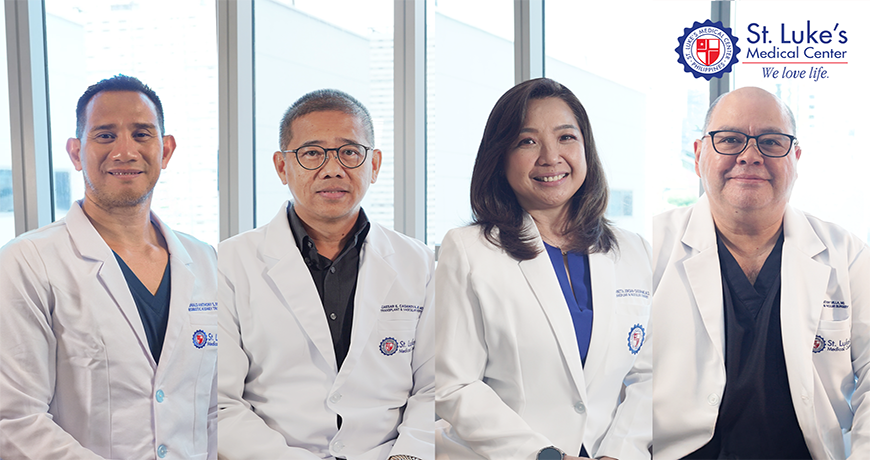St. Luke's Medical Center: A Southeast Asian First in Robotic-Assisted Kidney Transplant Surgery
From left to right: Dr. Ronald Anthony Faller, Dr. Caesar Casanova, Dr. Amornetta Casupang, and Dr. Martin Anthony Villa — the Robotic-Assisted Kidney Transplant Surgery Team
St. Luke's Medical Center has firmly established itself as a leader in renal care innovation by becoming the first hospital in the Philippines and Southeast Asia to offer robotic-assisted kidney transplant surgery. In just two years, this groundbreaking program has significantly expanded treatment options for patients with renal disease. It has been recognized with the Joint Commission International (JCI) Clinical Care Program Certification (CCPC) for its Kidney Transplant Program — the first and only such recognition in the region.
"We've already completed six successful robotic-assisted kidney transplants at St. Luke's," shared Dr. Ronald Anthony Faller, robotic transplant and vascular surgeon at St. Luke's Global City and Quezon City.
Dr. Faller led the surgical team that performed the hospital's inaugural robotic-assisted kidney transplant in December 2023.
"This milestone reinforces our commitment to delivering world-class, high-quality patient care," he added.
Minimally Invasive Surgery, Maximized Patient Recovery
Robotic-assisted kidney transplantation offers a less invasive alternative to traditional open surgery — a significant advancement for many patients.
"This approach results in smaller incisions, faster recovery, and shorter hospital stays," explained Dr. Caesar Casanova, robotic-assisted kidney transplant and vascular surgeon at St. Luke's.
"In open kidney transplant surgery, we often make large incisions — usually about six inches or more — which can involve cutting through muscle," added Dr. Martin Anthony Villa, Transplant and Vascular Endovascular Surgeon at St. Luke's Global City and Quezon City.
Dr. Villa emphasized a concerning trend: an increase in patients with high Body Mass Index (BMI) undergoing dialysis — a development tied to modern lifestyle diseases.
"More patients today are on dialysis, many of whom have diabetes or have high BMI due to unhealthy lifestyles. Unless we collectively shift toward healthier living, the number of patients with renal disease and diabetes will continue to grow," he cautioned.
"Many renal disease patients face added surgical risks because of increased abdominal fat and high BMI," said Dr. Faller. "Traditional open surgery involves larger incisions, which increases the risk of complications. With robotic-assisted surgery, we use minimal incisions, reducing pain, a lower risk of infection, and quicker recovery."
Da Vinci Xi: Precision at the Forefront
This surgical breakthrough is made possible by the Da Vinci Xi Surgical System — an advanced robotic platform that enhances precision, control, and visibility.
"With robotic-assisted techniques, we avoid cutting through muscle tissue," said Dr. Casanova. "We gently separate the muscle instead, which significantly reduces postoperative discomfort and facilitates a quicker return to normal activities."
Dr. Amornetta Casupang, Transplant and Hepatobiliary Surgeon at St. Luke's, underscored the transformative impact of robotic-assisted surgery on cosmetic and postoperative outcomes.
"While traditional open surgeries can leave huge scars, robotic-assisted kidney transplants leave 2-inch incisions with very minimal scarring," Dr. Casupang explained.
She recounted one patient's reaction, "It's as if I didn't have a kidney transplant at all," the patient said, amazed by the nearly invisible scar. Beyond aesthetics, the smaller incisions reduce the need for extended bed rest or postoperative pain medication.
"In open surgery, we often assess post-op patients by looking at which side the surgery was done. Now, with robotic-assisted methods, you can't even tell," she said. "That can have a huge psychological and emotional impact on the patient."
Human Expertise Behind the Technology
While robotic systems transform surgical precision, the surgeon's role remains essential.
"It's called robotic-assisted surgery for a reason," Dr. Casanova emphasized. "The robot doesn't make decisions — the surgeon does. It mirrors the surgeon's movements with precision, but clinical judgment and experience determine outcomes."
"At St. Luke's, our highly trained team leverages this cutting-edge technology to maintain the highest standards of patient care," added Dr. Faller.
Setting the Standard in Southeast Asia
As a regional healthcare pioneer, St. Luke's Medical Center is proud to lead the way in robotic-assisted kidney transplantation, offering renewed hope and a second chance at life for patients with chronic kidney disease.
Through continued investment in advanced surgical technologies and multidisciplinary care, St. Luke's Medical Center reaffirms its commitment to delivering world-class medical services and setting new benchmarks in patient care.
"Filipinos deserve access to this kind of innovation," the robotic transplant team emphasized. "This program is not just changing lives—it's putting the Philippines on the map as the first country in Southeast Asia to perform robotic-assisted kidney transplant surgery successfully."
With a team of highly skilled surgeons and the latest in robotic-assisted technology, St. Luke’s Medical Center continues to pioneer advanced solutions in kidney transplantation. The medical team’s commitment to innovation and patient-centered care ensures safer procedures, faster recovery times, and improved outcomes for patients in need of life-saving transplants.
To learn more about St. Luke’s Medical Center’s kidney transplant surgery options, consult your nephrologist.
Book an Appointment





